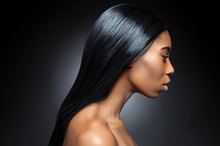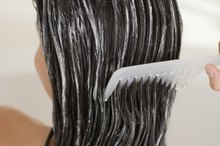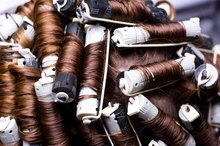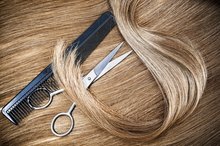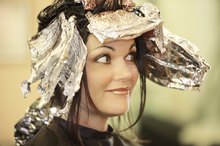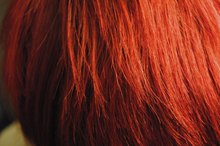Why Does Getting a Perm Cause Your Hair to Fall Out?
If you've ever had a hair perm, you probably noticed a strong chemical smell in the salon, and maybe some minor hair loss or sensitivity once the treatment was done. Yet for many women, the after-effects of a "permanent wave" or other chemical treatment can be nothing short of disastrous. Some experience major hair loss after getting a perm. Before going for a chemical treatment, understand the risks involved in perming or relaxing hair.
History
Women and men have been styling their hair for millennia. It is not rare that a person with straight hair wishes to "go curly," and a curly-haired person wishes to make her hair straight. However, before the late 1800s, hairstyles could only be changed temporarily. In 1906, the first permanent-wave machine was invented, and lye was discovered shortly thereafter 1. Although the techniques and chemical processes have evolved significantly, lye is still an active ingredient in many hair relaxers and still causes frequent scalp burns and hair loss.
- Women and men have been styling their hair for millennia.
- It is not rare that a person with straight hair wishes to "go curly," and a curly-haired person wishes to make her hair straight.
Chemical Burns
What Are the Dangers of Relaxing Hair?
Learn More
According to Skin Biology, lye or sodium hydroxide has a pH factor of 10 to 14. It penetrates the hair shaft, changing its structure. However, it can simultaneously penetrate the scalp and cause chemical burns. In an extreme case from 2005, a North Carolina woman used an at-home chemical treatment containing lye and claims to have received severe chemical burns within five minutes, eventually losing all of her hair. TeensHealth from Nemours claims that even "no-lye" relaxers and perms can carry similar risks, causing moderate to severe irritation, especially if your scalp already is sensitive 4.
- According to Skin Biology, lye or sodium hydroxide has a pH factor of 10 to 14.
- TeensHealth from Nemours claims that even "no-lye" relaxers and perms can carry similar risks, causing moderate to severe irritation, especially if your scalp already is sensitive 4.
Breakage
A more common type of hair loss from perms is breakage. A hair strand is composed of multiple layers, with an outer layer that forms a protective sheath around the delicate inner strands. Perms and relaxers can damage that outer layer, causing hair to become dry and break off. Once the damage is done, it cannot be repaired.
- A more common type of hair loss from perms is breakage.
- Perms and relaxers can damage that outer layer, causing hair to become dry and break off.
Avoiding Hair Loss
Harmful Effects of Conditioner
Learn More
If you're considering perming or relaxing your hair, it's best to see a professional stylist. A stylist can assess your hair's condition and choose the best product for you. You should also prepare for a treatment by making sure your scalp is very healthy, and avoiding brushing your hair or scratching your head during the day before you see your stylist. This avoids any scalp lacerations or irritations, making you less susceptible to chemical burns and damaged hair follicles.
- If you're considering perming or relaxing your hair, it's best to see a professional stylist.
- You should also prepare for a treatment by making sure your scalp is very healthy, and avoiding brushing your hair or scratching your head during the day before you see your stylist.
Caring for Permed Hair
Apply a good conditioner directly after perming your hair to restore some of its natural oils and proteins. Continue to deep condition your hair regularly to ward off breakage. Treat your hair gently, avoiding blow dryers and other heat styling products. If you take good care of your hair and have it treated only by professionals, you can keep it in optimum condition and enjoy long, healthy, beautiful styles 4.
- Apply a good conditioner directly after perming your hair to restore some of its natural oils and proteins.
- If you take good care of your hair and have it treated only by professionals, you can keep it in optimum condition and enjoy long, healthy, beautiful styles 4.
Related Articles
References
- Karl L. Nessler Permanent Wave Machine
- Skin Biology: The Truth About Hair Relaxers
- Lawyers and Settlements: Hair Perm Causes Total Hair Loss
- TeensHealth: Taking Care of Your Hair
- Phillips TG, Slomiany WP, Allison R. Hair Loss: Common Causes and Treatment. Am Fam Physician. 2017;96(6):371-378.
- Watras MM, Patel JP, Arya R. Traditional anticoagulants and hair loss: a role for direct oral anticoagulants? A review of the literature. Drugs Real World Outcomes. 2016;3(1):1-6. doi:10.1007/s40801-015-0056-z
- Urysiak-czubatka I, Kmieć ML, Broniarczyk-dyła G. Assessment of the usefulness of dihydrotestosterone in the diagnostics of patients with androgenetic alopecia. Postepy Dermatol Alergol. 2014;31(4):207-15. doi:10.5114/pdia.2014.40925
- Vincent M, Yogiraj K. A descriptive study of alopecia patterns and their relation to thyroid dysfunction. Int J Trichology. 2013;5(1):57-60. doi:10.4103/0974-7753.114701
- Peters EMJ, Müller Y, Snaga W, et al. Hair and stress: A pilot study of hair and cytokine balance alteration in healthy young women under major exam stress. PLoS ONE. 2017;12(4):e0175904. doi:10.1371/journal.pone.0175904
- Pratt CH, King LE, Messenger AG, Christiano AM, Sundberg JP. Alopecia areata. Nat Rev Dis Primers. 2017;3:17011. doi:10.1038/nrdp.2017.11
- American Academy of Dermatology. Alopecia Areata: Overview.
Writer Bio
An award-winning blogger, Jessica Blue has been promoting sustainability, natural health and a do-it-yourself attitude since graduating University of California, Berkeley in 2000. Her work, seen in a wide variety of publications, advocates an environmentally-responsible and healthy lifestyle.
